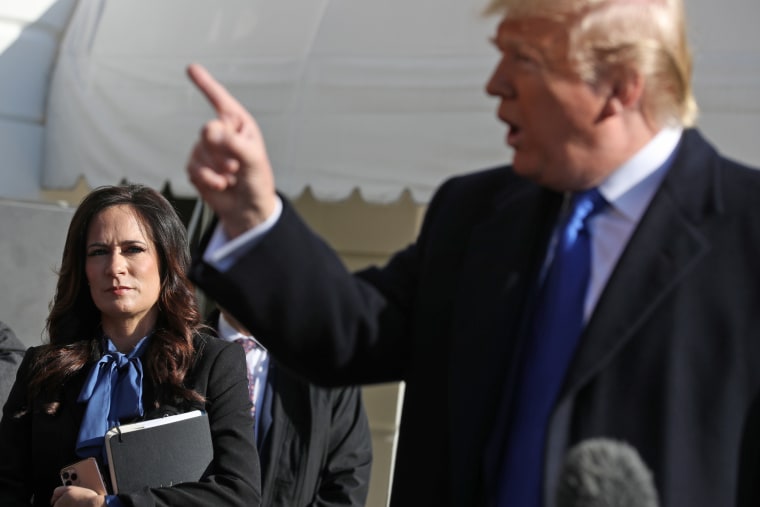It’s not secret that an amazing number of people who worked closely with Donald Trump — handpicked officials who saw how the then-president worked, thought, and led — can now barely contain their contempt for him. It’s an unprecedented dynamic that the Republican has struggled to explain away.
But while much of the list features former cabinet secretaries, quite a few top officials from the Trump White House seem to loathe the former president, too. As The Daily Beast reported, MSNBC’s Alex Witt talked to one such official over the weekend.
Stephanie Grisham, former Communications Director and Press Secretary under ex-president Donald Trump, told MSNBC’s Alex Witt that Trump had shown classified documents to visitors at Mar-a-Lago, his Palm Beach resort. “I watched him show documents to people at Mar-a-Lago on the dining room patio,” Grisham said. “So he has no respect for classified information. Never did.”
As part of the same segment — which MSNBC has posted online — Trump’s former press secretary also said that he was “loose” with sensitive documents. Grisham added that the former president’s willingness to share classified information with those who haven’t received security clearance is “a disservice to the country, but it also puts people in danger potentially.”
To be sure, this is a relatively vague account. Grisham said she’s personally seen Trump show sensitive information to people at Mar-a-Lago’s dining room patio, but we don’t know which documents, who might’ve seen them, or when such incidents might’ve occurred.
That said, Grisham’s account is easy to believe — because there’s so much recent history that dovetails with her claims.
Trump’s unsealed federal criminal indictment, for example, highlights two separate instances in which the former president allegedly showed classified documents to those lacking the necessary clearance: Once by showing a classified map to someone who was described as “a representative of his political action committee,” and then again when he showed a “highly confidential” war plan to a writer. (“Secret. This is secret information. Look, look at this,” Trump was recorded saying, adding, “Isn’t that incredible?” ... It’s so cool.”)
But those are incidents that occurred after Trump left the White House. While he was still in the White House, the Republican also demonstrated an unnerving carelessness with national security information. It happened so many times that I was able to put together a Top 10 examples of the phenomenon:
#10. In May 2017, Trump had a chat with Philippine President Rodrigo Duterte in which the Republican shared information about dispatching two nuclear submarines off the coast of the Korean peninsula. By one account, Pentagon officials were “in shock“ over Trump’s willingness to share such information. “We never talk about subs!” three officials told BuzzFeed News, referring to the military’s belief that keeping submarines’ movements secret is key to their mission.
#9. In September 2019, during a photo-op at an event along the U.S./Mexico border, the president seemed eager to boast to reporters about detailed technological advancements in border security. It fell to Lt. Gen. Todd Semonite, the acting head of the Army Corps, to interject, “Sir, there could be some merit in not discussing that.”
#8. In July 2019, Trump had an unsecured conversation with U.S. Ambassador to the E.U. Gordon Sondland, while the ambassador was in a Ukrainian restaurant within earshot of others, in which Trump sought information on Ukraine helping target the president’s domestic political opponents. Larry Pfeiffer, a former senior director of the White House Situation Room and a former chief of staff to the CIA director, said of the call, “The security ramifications are insane.”
#7. In February 2018, Trump ignored the pleas of many U.S. officials and recklessly declassified information from the so-called “Nunes Memo” in the hopes of advancing a partisan scheme.
#6. In February 2017, Trump discussed sensitive details about North Korea’s ballistic missile tests with the prime minister of Japan at a Mar-a-Lago dining area, in view of wealthy civilians/customers.
#5. In early October 2019, Trump publicly discussed American nuclear weapons in Turkey, something U.S. officials have traditionally avoided disclosing and/or confirming.
#4. In August 2019, Trump published a tweet about a failed Iranian launch, which included a detailed photo. As MSNBC’s Andrea Mitchell reported, it wasn’t long before experts marveled at Trump’s recklessness with classified material.
#3. In October 2019, Trump needlessly blurted out all kinds of tactical and operational details about the al-Baghdadi mission in Syria. As NBC News reported at the time, “A few of those colorful details were wrong. Many of the rest were either highly classified or tactically sensitive, and their disclosure by the president made intelligence and military officials cringe, according to current and former U.S. officials.”
#2. In 2020, Trump disclosed the existence of a secret nuclear weapons program to Bob Woodward, to the surprise of national security insiders.
#1. Just four months into Trump’s presidency, he welcomed Russian Foreign Minister Sergei Lavrov and Russian Ambassador to the U.S. Sergei Kislyak into the Oval Office — at the request of Russian President Vladimir Putin — for a visit that was never fully explained.
It was in this meeting that Trump revealed highly classified information to his Russian guests for no apparent reason. The Washington Post reported at the time, “The information the president relayed had been provided by a U.S. partner through an intelligence-sharing arrangement considered so sensitive that details have been withheld from allies and tightly restricted even within the U.S. government, officials said.”
The Wall Street Journal added, “According to one U.S. official, the information shared was highly sensitive and difficult to acquire and was considered extraordinarily valuable.” It’s never been altogether clear why Trump simply handed this to Putin’s representatives.
This list, incidentally, is not comprehensive. There are other examples.
At this point, there is definitive evidence that bolsters the observations Grisham made on the air, but given everything we’ve learned about how the former president treats sensitive documents, is it really that difficult to believe?
This post updates our related earlier coverage.

